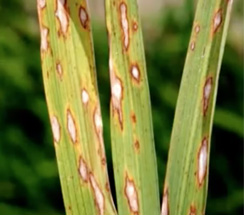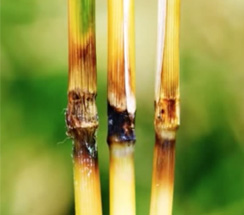Agricultural crops :: Cereals :: Rice
Blast :Magnaporthe oryzae (Syn: P. grisea, Magnaporthe grisea) |
|
|
Symptoms:
- The fungus attacks the crop at all stages of crop growth from seedling to late tillering and ear heading stage.
- Symptoms appear on leaves, nodes, rachis, and glumes.
- On the leaves, the lesions appear as small bluish green flecks. The lesions soon enlarge under moist weather to form the characteristic spindle shaped spots with grey centre and dark brown margin (Leaf blast). The spots coalesce as the disease progresses and large areas of the leaves dry up and wither. Spots also appear on sheath. Severely infected nursery and field appear as burnt.
- Black lesions appear on nodes girdling them. The affected nodes may break up and all the plant parts above the infected nodes may die (nodal blast).
- Nodal infection causes the culm to break at the infected area
- Inter nodal infection also occurs at the base of the plant which causes white panicles similar to that induced by yellow stem borer or water deficit
- Lesions on the neck are grayish brown and causes the girdling of the neck and the panicle to fall over
- If infection of the neck occurs before milky stage, no grain is formed, but if infection occurs later, grains of poor quality are formed
- Lesions on the branches of the panicles and on the spikelet pedicels are brown to dark brown
- The size and shape of the spots vary on different rice varieties.
|
| |
 |
|
 |
|
 |
|
| |
LEAF BLAST |
|
NODAL BLAST |
|
N BLAST |
|
|
|
|



